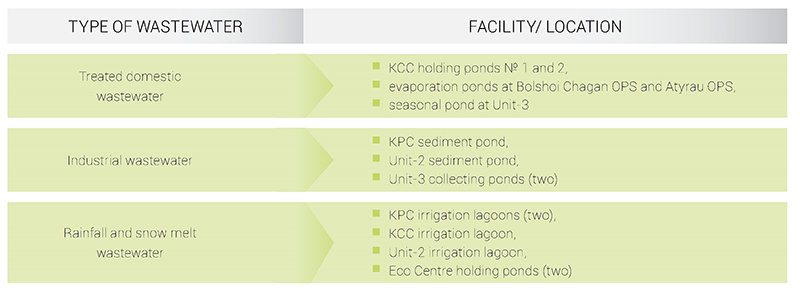Sustainability
- Home
- /
- Sustainability
- /
- Water use and disposal
- /
- Discharge of treated wastewater
Discharge of treated wastewater
KPO uses special man-made facilities for collecting treated domestic and industrial wastewater and storm runoffs. These facilities exclude a possibility of contaminants soaking into the soil and reaching groundwater as well as allow collecting the treated wastewater for their re-use for technical needs, thereby reducing the fresh water intake.
KPO wastewater collection facilities

Formation water, produced with crude hydrocarbons, and process wastewater are treated and injected into the deep-lying formations of the KOGCF industrial wastewater burial sites 1 and 2. Wastewater injection is the international practice of disposing wastewater, avoiding the formation of salt-containing waste on the surface during the treatment. Due to the reliable water shutoff and soil properties, which are ideal for the injection of wastewater, the migration of wastewater into upper aquifers is ruled out. According to the RoQ legislation, the volume of discharged wastewater and amount of discharged contaminants are regulated by the special permits.
Wastewater generated as a result of the KPO economic and production activities is not discharged into the natural water bodies.
Table below shows the KPO discharge volumes in 2019 — 2021 by wastewater types and receiving facilities.
Total discharge volume and contaminants by wastewater types and receiving facility, 2019 — 2021, m3
Receiving facility | Type of wastewater | 2021 | 2020 | 2019 | ||||
Discharge volumes, m3 | Amount of contaminants, tonnes | Discharge volumes, m3 | Amount of contaminants, tonnes | Discharge volumes, m3 | Amount of contaminants, tonnes | |||
Holding ponds | Treated domestic wastewater | 72,123 | 44.51 | 64,244 | 34.38 | 68,763 | 35.72 | |
Subsurface Waste Water Disposal Polygons | Industrial wastewater, process and produced wastewater | 780,755 | 58,935 | 694,893 | 45,970 | 628,819 | 39,645 | |
Terrain of Bolshoi Chagan OPS and Atyrau Terminal OPS | Rainfall and snow melt wastewater | 2,538 | 1,595 | 1,982 | 1.56 | 3,546 | 2.05 | |
Total discharge | 855,415 | 58,981 | 761,119 | 46,006 | 701,128 | 39,683 | ||
None: the volume of water discharge is metered using meters with data entered in the logbooks and further in the KPO water consumption metering database. The amount of contaminants discharged is determined by calculation as the product of the actual concentration of the contaminant before the discharge and the actual volume discharged.
Comparing to 2020, the volume of wastewater discharged by Company in 2021 increased by 12.38%. Of that, in 2021, the volume of injected industrial wastewater increased by 12.35% as compared to 2020. The increase in industrial wastewater was due to increase of produced water.
KPO monitors the content of contaminants in generated and treated wastewater at its facilities, such as:

In 2021, the discharge of contaminants amounted to 58,981 tonnes (which was 28.2% more compared to 2020 — 46,006 tonnes). Of them, 58,166 tonnes were discharged within the maximum permissible discharge (MPD) limits, while the excess discharge amounted to 815 tonnes.
Excessive discharge of contaminants was due to insignificant exceedance of the annual MPD limits in terms of hydrogen sulphide, chlorides and methanol content in wastewater injected into Subsurface Waste Water Disposal Polygons № 1 and № 2. Excessive discharge of contaminants with domestic wastewater to the holding ponds was not observed, except for a slight excess in ammonium nitrogen, chlorides, and phosphates. As provided by the RoQ Tax Legislation, the Company effected necessary payments for the discharges of contaminants.
In general, wastewater injection has no effect on the environmental components such as soil, flora and fauna, as wastewater is injected into effectively isolated deep horizons with high-mineralized groundwater that is not used for domestic and potable, balneological, process needs, irrigation or livestock farming.




